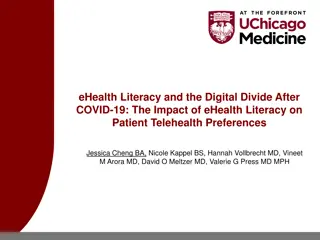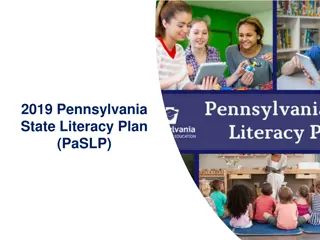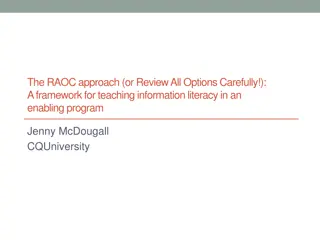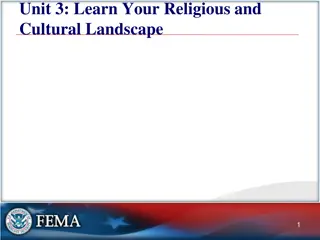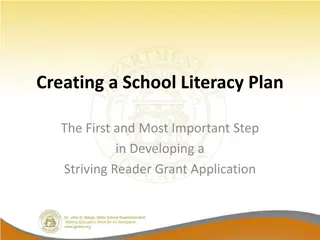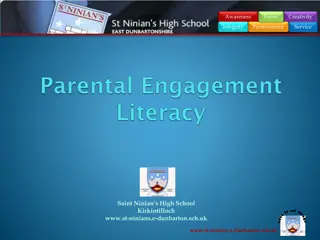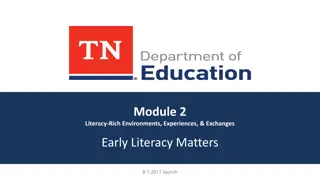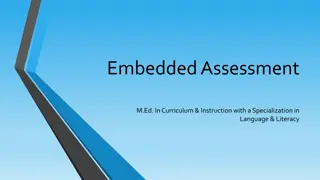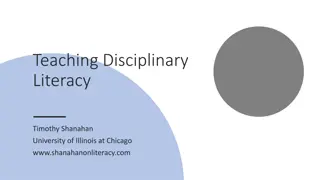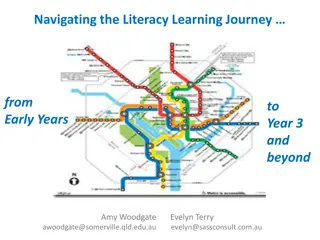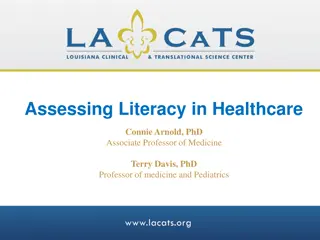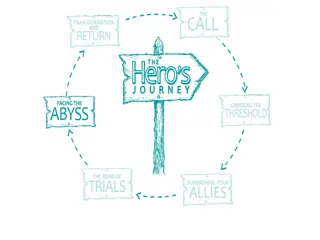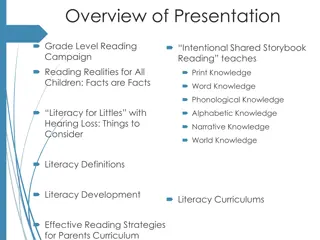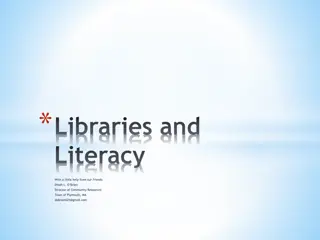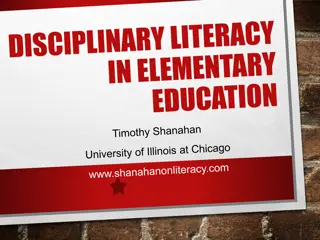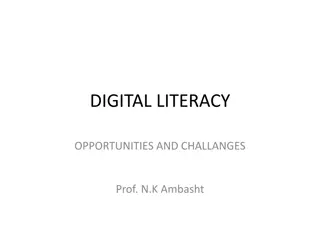Enhancing Literacy for Academic and Economic Success
Addressed by Timothy Shanahan of the University of Illinois at Chicago, this article underscores the critical importance of literacy in both academic achievement and economic success. The impact of literacy on overall academic performance as well as its influence on economic opportunities is emphasized, highlighting the need to prioritize and promote secondary literacy achievement for comprehensive educational and financial gains.
Download Presentation

Please find below an Image/Link to download the presentation.
The content on the website is provided AS IS for your information and personal use only. It may not be sold, licensed, or shared on other websites without obtaining consent from the author. Download presentation by click this link. If you encounter any issues during the download, it is possible that the publisher has removed the file from their server.
E N D
Presentation Transcript
Promoting Secondary Literacy Achievement Timothy Shanahan University of Illinois at Chicago www.shanahanonliteracy.com
Literacy attainment has strong impact on overall academic achievement (ACT, 2006; Baer, Cook, & Baldi, 2006) Literacy attainment has strong impact on economic well being (Ritchie & Bates, 2013; U.S. Department of Labor, 1992) Literacy attainment affects civic involvement (Venezky, Kaestle, & Sum, 1986 ) Literacy is Important Literacy attainment affects health (Baker, et al., 1996; National Center for Education Statistics, 2006) Literacy attainment affects social participation (Venezky, Kaestle, & Sum, 1986)
Secondary Literacy Achievement According to the NAEP (2015), only 37% of 12th graders in the U.S. are proficient readers Studies show that students can t read the required texts necessary when they leave high school college, career, military (Achieve, 2015; Military Officers Association of America, 2018; Nale, et al., 1998; Williamson, 2006; Workforce Readiness Project, 2006) Increasingly high schools are teaching with below grade level texts (Shanahan, 2013; Griffith & Duffett, 2018)
Question for Audience Discussion I m going to talk about 8 curriculum and instruction topics that, according to research, should be addressed to improve secondary literacy achievement Please, at your tables, try to anticipate what those 8 topics will be What s to be done to raise reading achievement in the secondary grades?
1. Focus on Vocabulary Instruction National Reading Panel (2001) reviewed 45 studies and found that explicit vocabulary teaching improved reading comprehension Explicit vocabulary teaching was the number 1 recommendation for improving reading achievement in What Works Clearinghouse practice guide (strong evidence) Research shows that vocabulary knowledge increases in importance as students advance through school (explaining increasingly large amounts of variation in reading comprehension) Studies show that vocabulary instruction (and incidental learning of vocabulary) are related to growth in reading comprehension ability Vocabulary is both an index of language knowledge and of domain or world knowledge (prior knowledge)
Increase student lexicons (known words and definitions) Increase ability to make sense of vocabulary within text (including sensitivity to meaning, morphology, context, reference skills, and persistence when word meanings aren t accessible) Vocabulary includes not just single words, but technical terms, metaphorical language, conceptual phrases, etc. (e.g., common currency, charming and charmed innocence, spartan lifestyle) Vocabulary Learning Goals
Dedicate a portion of class time to explicit instruction of words the students will confront in their reading Ensure that students receive repeated exposure to vocabulary in multiple oral and written contexts Teaching Vocabulary Give sufficient opportunity to use new vocabulary through discussion, writing, and extended reading. Provide instruction in morphology to ensure that they can use the words in a variety of ways
Rich vocabulary definition/Multiple definitions 1. Dictionary definition 2. Synonyms 3. Antonyms 4. Part of speech 5. Other forms/spellings 6. Category Rich definitions 7. Example 8. Picture 9. Act it out
Epitomize 1. Dictionary definition: perfect example of 2. Synonyms: typify, exemplify, represent, symbolize 3. Antonyms: misrepresent, distort, belie Vocabulary: Building the Lexicon 4. Part of speech: verb 5. Other forms/spellings: epitome, epitomizes, epitomized, epitomizing 6. Category: ways things can be like others (resemble, similar, etc.) 7. Example: Tupac epitomizes rap artists. 8. Image: 9. Act it out:
Vocabulary: Building the Lexicon Word Examples soothing soft music bath nap Definition Non-examples tests loud noises comforting, offering relief
Words are remembered best when they are connected to other words/ideas Various approaches connect words (synonyms, antonyms, categories, and comparisons of previous examples) Another way is semantic mapping Vocabulary: Building the Lexicon
Repeated and varied use (12 repetitions) All modes of language (reading, writing, speaking, listening, graphic/pictographic, kinesthetic) Personal connections (personal vocabulary lists, word wizards) Frequent review Vocabulary: Building the Lexicon
Coxheads Academic Word List http://www.cal.org/create/conferences/ 2012/pdfs/handout-4-vaughn- reutebuch-cortez.pdf Brown, Culligan, & Phillips New Academic Word List Sources of Vocabulary http://www.newgeneralservicelist.org/n awl-new-academic-word-list Davies Academic Word Lists https://www.academicwords.info/x.asp
It is essential that students have metacognitive awareness during reading Metacognitive awareness Vocabulary: Sensitivity to meaning It is important to try to make sense of text even when you don t know all the words, also essential to be aware of when you don t know the meaning of words They need to be sensitive to their lack of understanding of words
Morphology refers to the study of how words are formed by analyzing the structure of words and word parts such as stems, root words, prefixes, and suffixes. Words meanings can sometimes be figured out from morphology (breaking words into their meaningful parts) This kind of work is best done with words that students are confronting in their reading Vocabulary: Morphology
84 most common Greek & Latin Roots https://d3jc3ahdjad7x7.cloudfront.net/1Wfu6ZLa 3Dx2jxFtkGxgyFP5iVqUQNJ2yWyEqNu6ljtNEkJ1.pd f Vocabulary: Morphology Greek/Latin Roots, Prefixes, & Suffixes https://msu.edu/~defores1/gre/roots/gre_rts_afx2. htm 50 GRE Root Words https://www.prepscholar.com/gre/blog/gre-root- words/
Vocabulary can be taught, but students also need to learn to figure out vocabulary from context Tests like the ACT do not allow use of reference books, nor can teachers provide assistance with vocabulary Vocabulary: Using context Most textbooks (and teacher published lesson plans) emphasize the preteaching of vocabulary to prepare students to comprehend texts Unfortunately, they often make poor choices of the words to preteach
You are reading a text and there are multiple words that you are unsure of you can t figure out their meanings from context or morphology and you can t ask anyone for help. What do you do? What many students do is discontinue reading. They do not find it easy to proceed when they are clearly missing basic information. Vocabulary: Persistence However, it is better in such a situation to proceed as well as you can... to stick with the text trying to understand each sentence as well as you can, guessing when you have to, or skipping an idea here or there Sometimes 50% comprehension is best (it is certainly better than 0%)
2. Teach Comprehension Strategies National Reading Panel identified 204 studies demonstrating that explicit instruction in comprehension strategies improved reading achievement What Works Clearinghouse Practice Guide made comprehension strategy instruction its second recommendation (evidence strong)
Summarizing both within paragraphs and across texts Self-questioning about what they have read The strategies shown to be beneficial Paraphrasing what they have read Drawing inferences that are based on text information and prior knowledge Self-monitoring comprehension
The most effective way to teach strategies is gradual release of responsibility Teacher demonstrates strategy and explains its purpose, value, and how and when to implement it Gradual release of responsibility Teacher guides students to implement the strategy while explaining its purpose, value, and implementation Teacher gradually withdraws this support until students are implementing it individually
Make sure the text is sufficiently difficult--so that it requires the application of a strategy Make sure the text fits the strategy (and explain to students how you recognize when to use a particular strategy) Instructional Hints Show students how to apply a strategy to various types of texts Multiple strategies are more beneficial than single strategies
Teacher provides insufficient guided practice Problems to avoid Teacher doesn t recognize the need to alter the sequence of teaching based on student response So much attention is given to the strategy that the content of the text is ignored or lost
Question for the Audience What barriers exist in your school or school district to providing high quality vocabulary and comprehension strategy instruction?
3. Use and Build Knowledge Text is interpreted through the lens of prior knowledge that is the knowledge that the reader brings to the text Knowledge is used to reduce processing demands during reading, to reduce ambiguity, to support inferences, to reduce amount of required learning
Activating Prior Knowledge Studies show that activating prior knowledge can improve comprehension This can be done quite simply by revealing a known topic or getting students to explore their knowledge on the topic
"The procedure is actually quite simple. First you arrange items into different groups. Of course one pile may be sufficient depending on how much there is do. If you need to go somewhere else due to a lack of facilities, then this is the next step; otherwise, you are pretty well set. It is important not to overdo things. That is, it is better to do too few things at once than too many. In the short run, this may not seem important but complications can easily arise. A mistake can be expensive as well. At first, the whole procedure will seem complicated. Soon, however, it will become just another facet of life. It is difficult to foresee any end to the necessity for this task in the future, but then, one can never tell. After the procedure is completed, one arranges the materials into different piles again. Eventually they will be used one more and the whole cycle will then have to be repeated. However, that is part of life."
Washing Clothes "The procedure is actually quite simple. First you arrange items into different groups. Of course one pile may be sufficient depending on how much there is do. If you need to go somewhere else due to a lack of facilities, then this is the next step; otherwise, you are pretty well set. It is important not to overdo things. That is, it is better to do too few things at once than too many. In the short run, this may not seem important but complications can easily arise. A mistake can be expensive as well. At first, the whole procedure will seem complicated. Soon, however, it will become just another facet of life. It is difficult to foresee any end to the necessity for this task in the future, but then, one can never tell. After the procedure is completed, one arranges the materials into different piles again. Eventually they will be used one more and the whole cycle will then have to be repeated. However, that is part of life."
What if students lack prior knowledge? Activating Prior Knowledge (cont.) One possibility is to identify the critical information that may be necessary Science texts may not signal the relationship between two ideas (e.g., however, therefore, thus, for example, furthermore, in addition) assuming readers would have sufficient knowledge (Biber & Gray, 2010) Introduce this information prior to reading (trying to minimize the explicit text information that you reveal)
Analyze the text information in relation to what you already know (Hattan, 2019) Activating Prior Knowledge (cont). This kind of analysis focuses on the relationship of text information to prior knowledge, rather than to either text or knowledge alone
Anomoly (discrepan- cies) Analogy (similarities) Antinomy (exclusivity) Antithesis (opposition)
Provide text sets for students to read on a particular topic (these texts should vary in difficulty) Activating Prior Knowledge (cont). Have students read the whole set (don t jigsaw) The easier texts should be read first these serve as scaffolds for the more demanding texts
Question for the Audience What role should oral reading play in secondary literacy improvement?
4. Teach Oral Reading Fluency Oral reading fluency refers to the ability to read text accurately, with sufficient speed, and prosody Accuracy refers to reading the author s words Sufficient speed is not hurried reading or speed reading the student is able to read at normal speaking rate (can recognize/decode words fluently enough that it doesn t interfere with comprehension) Prosody or expression refers to proper pausing and intonation consistent with punctuation and meaning The reason for focusing on oral reading fluency instead of silent reading fluency is the difficulty of evaluating silent reading fluency
Oral Reading Fluency The National Reading Panel found that fluency instruction led to improved reading comprehension in grades 1-4 and with remedial readers in grades 1-12 Rasinski et al. (2005, 2018) found substantial numbers of high school and community college students who were too disfluent to comprehend
Oral reading practice with sufficiently difficult texts -- texts the students are not already fluent with (Kuhn & Stahl, 2001) Repetition rereading the text to develop fluency (NICHD, 2000) Fluency instruction Prosody support chunking or parsing of texts (Cutler, et al., 1997) Extensive reading practice (Iwahori, 2008)
The Portrait of a Lady by Henry James, Under certain circumstance /there are few hours in life /more agreeable /than the hour dedicated / to the ceremony known as afternoon tea. /There are circumstances/ in which, /whether you partake of the tea /or not / some people /of course /never do, -- /the situation is in itself delightful. /Those that I have in mind /in beginning to unfold this simple history /offered an admirable setting /to an innocent pastime. /The implements of the little feast /had been disposed upon the lawn /of an old English country-house, /in what I should call /the perfect fiddle /of a splendid summer afternoon. /Part of the afternoon had waned, /but much of it was left, /and what was left /was of the finest and rarest quality. /Real dusk would not arrive /for many hours;/ but the flood of summer light /had begun to ebb, /the air had grown mellow,/ the shadows were long /upon the smooth, dense turf. /They lengthened slowly,/ however, /and the scene expressed /that sense of leisure /still to come /which is/ perhaps /the chief source /of one's enjoyment /of such a scene /at such an hour./ From five o'clock to eight /is on certain occasions /a little eternity; /but on such an occasion as this/ the interval could be only an eternity of pleasure. /
5. Have Students Write about Text Writing is important, of course Here my emphasis is not on teaching writing for its own value Instead I am focusing on the idea of using writing activity to extend or improve reading ability
Research shows that reading and writing are highly related engaging in writing can have positive impacts on decoding, vocabulary knowledge, and reading comprehension (Shanahan, 2005, 2012) Writing about Text (cont.) Graham & Hiebert (2010) meta-analyzed more than 100 studies in which students wrote about the texts that they read 93% of the findings were positive writing about text both improved reading comprehension and increased student recall of the information that they had read/wrote about
Modelingtrying to create a text similar to the model text Summarization trying to summarize the major ideas of the text Writing to Increase Learning Critique/analysis writing an extensive evaluation and/or analysis of the ideas in a text Synthesis combining the information from multiple texts
6. Provide Appropriate Remedial Support Some students enter secondary school far behind in reading These students can benefit from appropriate interventions Some students may be so far behind that they may need an intensive phonics/decoding intervention However, most secondary remedial students are beyond this needing additional teaching in vocabulary, fluency, reading comprehension, and writing (written language)
Secondary Remediation Itis essential that these students receive a period of specific reading instruction, and that they do accountable reading and writing in all of their classes (Bohr, 1994) Low achieving students are not likely to make sufficient gains from an intervention to allow them to catch up or to be successful
Audience Question What do you currently do about low achieving readers? Do you have interventions aimed at both decoding (for the severely disabled) and written language (for those closer to grade level)? Are these interventions successfully raising student achievement?
7. Teach Disciplinary Literacy Each discipline creates a particular kind of knowledge that is the result of the particular methods of scholarship used in that field (Shanahan & Shanahan, 2008) This specialization requires the creation and use of different kinds of texts and different ways of thinking about and using those texts Disciplinary literacy refers to the specialized or unique ways that texts are used to create, disseminate, or evaluate knowledge in the various fields of study
I am not going to talk about disciplinary literacy here because I am giving a separate talk on that However, given the likely insufficiency of most secondary school reading interventions, it is essential that students read and write within their subject matter classes, too Disciplinary Literacy (cont) Disciplinary literacy insights and routines are what teachers in those classes will need to rely upon if they are going to engage students in discipline- appropriate literacy practices in their classrooms
8. Teaching with Complex Texts One of the major reasons that secondary teachers do not engage students in discipline-appropriate literacy practices is because often students struggle to read these texts Because these teachers are uncertain about how to deal with this effectively, they avoid text (e.g., lecturing, reading to the students, using round robin reading) Additionally, many secondary ELA teachers believe that students will only improve in reading if they are taught with instructional level text
Teaching with Complex Text (cont.) Increasingly studies are showing that secondary students do better with grade level texts than with easier texts aimed at facilitating their reading (e.g., Lupo, et al., 2019) However, research shows that there is no such thing as an instructional level in reading (Shanahan, 2019)
Most states have adopted complex text educational standards requiring that students be taught to read texts of particular levels of difficulty (higher than in the past) Nevertheless, 45% of secondary teachers believe they are supposed to teach with texts at student reading levels only about half believe they should assign grade level texts (Rand, 2016) Mandate for Complex Text Secondary teachers are less likely to assign grade level texts to students than prior to the adoption of standards that specify particular levels of text (Fordham Foundation, 2018)
Complex Text Instruction ASSISTANCE WITH SYNTAX ASSISTANCE WITH COHESION ASSISTANCE WITH TEXT STRUCTURE PRIOR VOCABULARY SUPPORT FLUENCY PRACTICE KNOWLEDGE GUIDANCE





